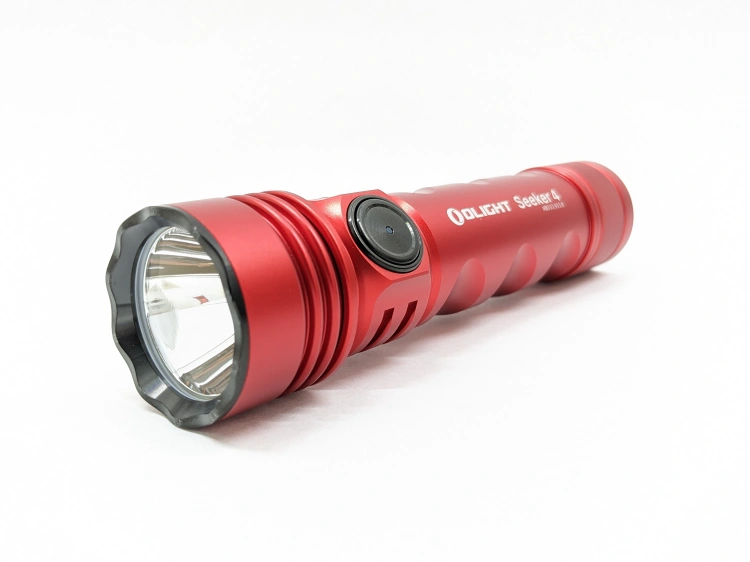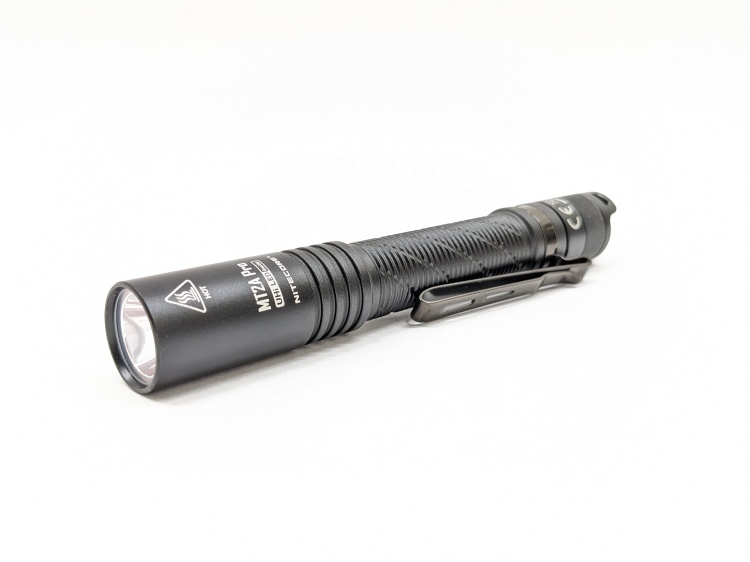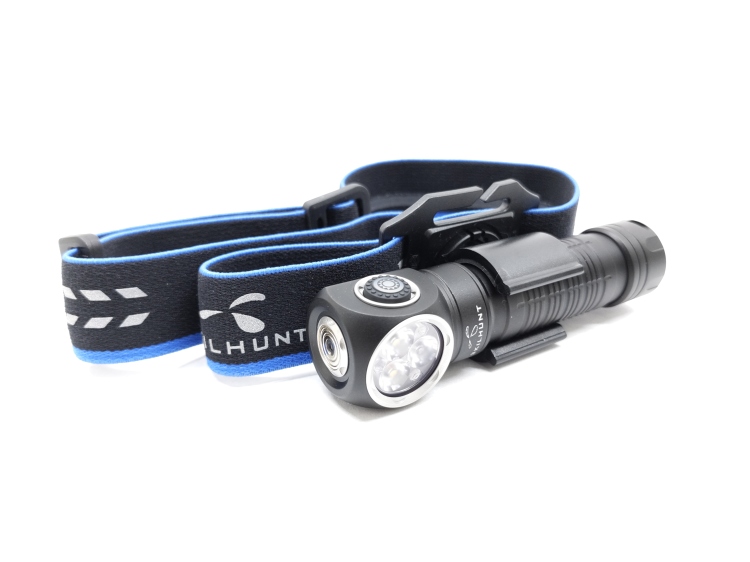Contents
- Pricing & Availability
- What comes in the box?
- Design & Construction
- Size & Measurements
- User Interface
- Mode Chart
- Runtime
- Driver & Regulation
- Emitter & Beam
- Switch
- Carry & Ergonomics
- Batteries & Charging
- Competition
- Conclusion
Pricing & Availability
Acebeam sent me this light in exchange for an honest review. Here is the official product page and here is the Amazon page where you can see current pricing. At the time of writing, it’s $70 on Amazon with a battery & fast shipping but $80 from Acebeam with a battery and slow shipping, so it seems Amazon is the place to buy it.
What comes in the box?
The box is simple. It’s made of white cardboard with a few details printed on it, and a large window showing the light. Inside, the light sits in an a vacuum formed plastic insert. It’s not quite as nice as the full size E70’s fancy magnetic-closure and foam insert, but it’s satisfactory. The following items are included in the box:
- The light itself
- Battery (installed in the light)
- 8″ long USB A-to-C cable
- Wrist lanyard
- User manual & warranty card
Design & Construction
Acebeam put a lot of effort into the styling of E70 Mini and I think it looks great. The head and tail flare out so it doesn’t just look like a plain tube. The outer body tube has channels cut out of it to show off the blue anodized inner body tube. There are slots and cutouts (several of which can fit glow tubes or tritium vials) all over the light for various inserts like Tritium vials. It’s very stylish, in a way that few lights are. It’s worth noting that the inner & outer body tubes cannot be separated for cleaning.
Build quality is excellent as I’ve come to expect from Acebeam. When you pick up E70 Mini, it has a feeling of density and solidity just like the full size E70. It’s hard to describe, but it strikes you in a way that other lights from most other brands don’t. The anodizing is very matte and chalky. The threads are anodized, well machined, and lubricated.
Right now E70 Mini is only available in Aluminum with a blue inner-tube. I asked Acebeam about other materials & sleeve colors and they said blue will be the only inner-tube color, but they may release other materials in the future.
Size & Measurements
Noctigon KR1 | Emisar D4V2 | Acebeam E70 Mini | Lumintop FW3X | Wurkkos TS10

| Measurement | Measured (mm) |
|---|---|
| Bezel Diameter | 26.0 |
| Maximum Head Diameter | 26.0 |
| Length | 111.1 |
| Switch Diameter | 13.5 |
| Switch Proudness | 0.0 |
| Lens Diameter | 20.8 |
| Lens Thickness | 1.2 |
| MCPCB Size | 20.0 |
| Body Tube Diameter (internal) | 19.1 |
| Body Tube Diameter (maximum) | 26.0 |
| Body Tube Diameter (mode) | 23.4 |
| Body Tube Length | 88.6 |
| Ride Height (sticking out of pocket) | 12.7 |
| Pocket Clip Space (for pants material) | 4.2 |
| Pocket Clip Space (at mouth) | 2.7 |
| Pocket Clip Width | 9.0-15.5 |
| Pocket Clip Thickness | 1.0 |
| Driver Diameter | Unclear |
| Included Battery Length | 71.6 |
| Included Battery Diameter | 18.8 |
Weight without battery: 72g
Weight with included battery: 124g
User Interface
This UI may be one of E70 Mini’s biggest selling points but also one of its big deal-breakers.
The actions are # of presses followed by a hold (H) or a release (C). So, “1C” is one click and release. “2H” is two clicks but you hold down the last one.
| State | Action | Result |
|---|---|---|
| Off | 1C | No Result |
| Off | 1H | “Ultra-Low” (not memorized) |
| Off | 2C | On (mode memory) |
| Any | 3C | Strobe |
| Ultra-Low | 1H | Low (memorized) |
| On | 1C | Off |
| On | 1H | Cycle Mode (Low > Med 1 > Med 2 > High, memorized) |
| On | 2C | Turbo (not memorized) |
| Turbo | 2C | Memorized Mode |
In an effort to prevent pocket activation, Acebeam decided to require two clicks to turn E70 Mini on. While preventing accidental activation is a noble cause, this is the wrong way to go about it. Accidental activation happens due to bad switch design, not bad UI design. With few exceptions, a single click should always turn a flashlight on and off. With 2C from off being required to turn the light on, there’s no direct access to Turbo mode.
This may not be a problem for some users, because it’s relatively easy to get used to it. For others it’s one of the most egregious UI design sins. If you’re like me and you use a wide variety of lights, you’ll have to re-learn the UI every time you switch to/from a different light because you’ll find yourself turning another light on Turbo when you don’t mean to, or find yourself fumbling with E70 Mini and wondering why it won’t turn on. I really wish Acebeam had used a more typical UI here and tackled accidental activation by using a different switch design.
With all that said, they did get a few things very right. 2C from Turbo goes back to the memorized level, and 1H from “Ultra-Low” goes to Low. Those are two critical components of a good UI that many manufacturers overlook. Well done, Acebeam.
Mode Chart
Disclaimer: All measurements taken at turn-on. Lumen measurements were taken on a Texas Ace 3.5″ Lumen Tube. A candela measurement was taken at 10 meters with an Opple Light Master III on the highest brightness, and other candela figures were calculated relative to that. CRI, CCT, & DUV data was taken for each mode from a few feet away at the center of the hotspot with the Opple Light Master and Waveform DUV Calculator. Runtime tests were performed with the Ceilingbounce app on my smartphone. All of these tests were performed with a fully charged included battery unless otherwise specified. I cannot measure moonlight directly, so moonlight readings are calculated based on the brightness relative to the next-lowest mode. None of this is professional equipment, so take all of these measurements with a grain of salt.

Above are the official specs, followed by my own measurements below.
| Level | Lumens | Candela | Throw (Meters) | CRI (Ra) | Color Temp. (K) | DUV (Tint) |
| Turbo | 1760 | 3800 | 123 | 97 | 5110 | -0.0022 |
| High | 760 | 1641 | 81 | 98 | 5060 | -0.0001 |
| Med 2 | 330 | 713 | 53 | 98 | 4960 | 0.0004 |
| Med 1 | 150 | 324 | 36 | 98 | 4860 | 0.0013 |
| Low | 58 | 125 | 22 | 98 | 4780 | 0.0017 |
| Ultra-Low | 9 | 19 | 9 | 98 | 4760 | 0.0016 |
Mode Spacing / Ramp Speed: is fine. There are no weirdly small or large jumps. In use it feels like there are too many modes though. Dropping the mode count to 5 instead of 6 would be better, I think.
That “Ultra-Low” 9-lumen mode is unfortunate. A true moonlight mode of 1 lumen (or even significantly less!) is critical for a lot of users. That 9 lumen lowest mode will disqualify E70 Mini as an EDC light for many people (including me).
Runtime

Performance: is great for a light this size. Sustained output of 500 lumens is very impressive, especially with high CRI LED’s. Turbo lasts for 1 minute before stepdown which is longer than some other hotrods this size. Turbo and High mode both get too hot to hold, but Med 2 just gets warm.
Thermal regulation: is not present as far as I can tell. I turned on a small fan during one of the runtime tests to cool the light and it did not affect output.
LVP: is present and works well. It’s built into the driver so unprotected cells won’t be over-discharged (if they will fit).
Driver & Regulation
Acebeam advertises E70 Mini as using a boost driver, which is fantastic! Boost drivers are very efficient and are often the best regulated of all the different kinds of drivers. There doesn’t appear to be an easy way to remove the driver, as there are no visible screws or a retaining ring.

Regulation is difficult to classify. The driver is capable of perfect regulation, but when the included cell gets low it’s susceptible to voltage sag under load. When the voltage sags, the light drops its brightness. All that happens in a matter of milliseconds, so despite the driver being capable of perfect regulation, the maximum achievable brightness is reduced as the battery drains. It may perform better with a higher drain cell like a Molicel P26A (if you have a spacer you can use to get it to fit).
Note: All regulation measurements are taken at turn-on so they do not reflect any thermal stepdowns that may occur. A value of 0 indicates low voltage shutoff immediately upon activation.
PWM: No PWM is visible nor audible. I did some testing on each mode with an Opple Light Master III and found no PWM on any mode.
Parasitic Drain: 50 microamps. That will take 7 years to drain the included batteries.
Emitter & Beam


Acebeam chose to use 5000K Nichia 519A’s in E70 mini. They are an excellent emitter choice for their very high CRI, high efficiency (for a high CRI LED) and neutral tint. They’re all the rage right now in the enthusiast community. They sit behind a standard Carclo 10507 optic, so swapping that out for different optics to fine tune the beam pattern should be easy. I asked Acebeam about other color temperatures and they said they plan to stick with 5000K only. I do hope they change their mind in the future, as I prefer something in the 3500-4000K range personally, and I think that would open this light up to more users.
The black steel bezel unscrews without any trouble. The lens & optic required me to stick tape to them to pull them out, but that’s not all that unusual. There’s a small o-ring that sits between the lens and the optic, and that required some fine tweezers to remove. It’s worth noting that E70 Mini is using a series configuration MCPCB, so if you want to do an emitter swap you can’t use one of the common parallel triple MCPCB’s.

The beam pattern is EDC perfection. It’s a wide, well-defined, even hotspot with a hard edge and dim spill that fades out to nothing. I considered de-doming the LED’s in my sample to lower the color temperature but I decided against it because I didn’t want to mess with this perfect beam profile.






In the beamshots above, the trees where I’m aiming the hotspot are 175M away. In the beamshots below, the park bench where I’m aiming the hotspot is 42M away.






Switch

On the tailcap is a large black steel e-switch. In and of itself it’s a good switch. It’s clicky and tactile with minimal travel and no wobble. If I had to find something to criticize I would say it’s too easy to press and should be changed to require a little more force to click.
The reason it’s not so great is that Acebeam decided to give E70 a double-click-on UI instead of designing a switch that doesn’t get activated by accident. If this switch were smaller, better shrouded, or took more force to actuate, that would be a much better solution than ditching single click on/off.
I’m happy to report that it does not have “www.acebeam.com” plastered on the tail like the full size E70. That was very tacky.
Carry & Ergonomics
Ergonomics are good. It’s just the right size to fill my XL-glove-size hands in a reverse grip, and the clip doesn’t create any hotspots at all. In a cigar grip, the flare at the tail provides plenty of grip. Even in a forward grip is still a good size and is comfortable. The matte anodizing and fancy milling really provide a nice amount of grip.
I love this pocket clip. The full size E70’s clip left a lot to be desired as it was a really boring and thin piece of stamped steel. The Titanium and Steel versions came with a fancy milled clip, but they were very expensive. E70 Mini brings the looks and function of that fancy milled clip down to a stamped-steel price point. There’s tons of space at the mouth and inside for pants material. The pinch point is nice and rounded and it lands on a flat spot so it slides in and out easily enough without tearing up your pants. Its held on with screws so it won’t pop off and fly into the next town if it gets caught on something. It carries reasonably deep and the whole clip is rounded to match the curvature of the light and provide better ergonomics. This is one of the best pocket clips I’ve ever seen on a light and I am very very picky about clips. Well done.
Tailstand: works great. Very stable.
Batteries & Charging

The biggest change going from E70 to E70 Mini is going from a 21700 battery down to an 18650 battery. Where E70 is a little too big and bulky for EDC, E70 Mini is probably small enough that most people could carry it.
Acebeam includes a battery in the box. It’s a 3100mah, protected, USB-C rechargeable cell. It’s very long, which causes some compatibility issues. The biggest one is that E70 Mini requires a really long cell to make electrical contact. That means that unprotected flat top cells do not work unless you use some kind of conductive spacer. I found this two pack of 18mm spacers from Convoy works perfectly, but that’s another thing you’ll need to buy. A neodymium magnet stuck to the negative end of the battery will work in a pinch but isn’t a great long-term solution. I wish Acebeam had chosen to use a shorter battery and/or longer springs.
The included battery has a USB-C charging port on it. C-to-C charging works fine and it can work as a powerbank, but only for some devices. My Google Pixel 4A smartphone won’t recognize or charge from it. Every other USB-C device I have will charge from it though, including another smartphone. A short (8″) USB A-to-C cable is included in the box for charging. Charging takes 3 hours and stops at 4.17V.
Competition
Here are some lights in the same class and how they compare.
Acebeam E70: same thing but larger with a 21700 battery and a single XHP70.2 or FC40, also available in fancy metals, lower moonlight
Noctigon KR4: shorter & wider, nice clip, unprotected flat top cells only, four LED’s instead of three, multiple driver options (including boost), Anduril 2 firmware, RGB aux LED’s, similar price (with boost driver & 519A’s), available in multiple colors and materials, lower moonlight
Lumintop FW3A: smaller, better Anduril UI, worse FET driver, only supports unprotected flat top cells, worse (but still fine) clip, no charging solution, less expensive, lots of body color options, different emitter options, lower moonlight
This section is not comprehensive. If I didn’t include a particular light here, it doesn’t mean it’s bad or doesn’t deserve to be here. I simply cannot list every possible competitor.
Conclusion
E70 Mini reminds me of a high end sports car. It’s beautiful with high quality and high performance parts, but it’s got weird quirks that take some significant adaptation to get around. The lack of a moonlight mode is like an overly-sensitive accelerator pedal: you can go, just not slowly. The double-click-on function is like the car automatically shutting off every time you come to a complete stop, so you have to start it again every time you want to accelerate from a stop.
With that said, Acebeam has made a gorgeous light. The inlaid blue signal tube & swirl cutouts give it a unique look like nothing else. The beam profile is delightful for EDC use and the LED’s are such a clean white with great color rendering. The clip might be my favorite clip design ever. It has a feeling of quality that’s difficult to fake and it’s just cool.
While it’s not perfect, E70 Mini has a tremendous amount of character, and that makes it special in a market where most manufacturers are just reiterating the same designs, Thanks to Acebeam for sending me this light for review!




































This would have to be the best and most in-depth review I’ve read, thanks for going into so much detail, I found it very helpful. I have one question, are you sure that the optic is a 10507? It just seems like a 10511 to me. The reason I ask is because I’d like to play around with different optics in it and just wanted another opinion.
LikeLike
The optic in my review sample was definitely a 10507, not a 10511. 10511 has a frosted finish and the front is flat. The optic shown in the photos of my review has a clear finish and the center of each optic cone is recessed. That’s the tell-tale sign of a 10507.
LikeLike